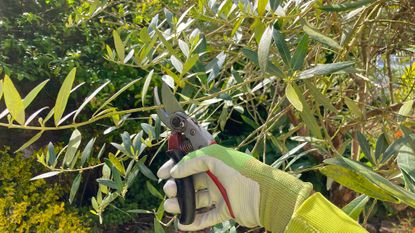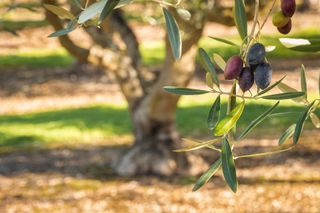How to prune olive trees – the best ways and when to prune
Learn how to prune olive trees to reduce their height, improve the shape and maximize fruit production


You need to know how to prune olive trees to keep them flourishing.
Olive trees, Olea europaea, are beautiful evergreens, ideal for containers or planted in the garden, but like most botanicals and other fruit trees you may be growing, they will need a prune. With a little tree care you will be rewarded with delicious, juicy homegrown olives.
Among the best evergreen trees for gardens, olive trees are native to the Mediterranean. They have a history of long life and have been found to live for one or even two thousand years aided by their virtually indestructible root system.
A symbol of abundance, olive branches are an emblem of peace, wisdom and fertility. Olives have been grown to eat for around 6,000 years. Either cured and marinated or pressed into oil, these small oval stoned fruits are packed with fiber, antioxidants and Oleic acid which have a wealth of health benefits.
In the USA olives can be grown in zones 9 - 11, flourishing in California, Arizona, Oregon, Florida, Texas, Alabama, Georgia and Maui Hawaii. With summers becoming more susceptible to drought, olive trees are a great choice for dry conditions, but learn when to plant fruit trees for the best results.
Once you have planted and established your tree, the next step is learning how to prune olive trees to keep your tree healthy and looking good.
How to prune olive trees – getting started

The first step in how to prune olive trees is to select the correct pruning tools.
A pair of hand pruners or bypass secateurs will cope with most branch widths, but if you are pruning a very large tree then it might be necessary to use loppers or even a hand saw.
When pruning fruit trees always ensure your tools are clean. Wash blades with disinfectant between pruning different trees and don’t forget your gloves.
‘Start with freshly sharpened, clean tools. As an organically trained horticulturalist, I use a citrus-based natural disinfectant, which is very effective against fungal and bacterial diseases that can get passed from plant to plant. I clean my secateurs and pruning saw in between pruning each tree just in case,’ explains horticulturalist and garden designer Nicola Hope.
Step-by-step guide for how to prune olive trees

When pruning olive trees, first walk around your tree and note the shape. Are there any obvious visible problems?
Cut out any dead, diseased or damaged branches. This will help the tree concentrate its energy into the healthy branches and stop fungal diseases spreading via infected stems. Make sure you remove any diseased material from your property, do not compost or chip or you will be reintroducing these diseases back into your soil.
Nicola Hope shares her step-by-step guide for how to prune olive trees:
- 'Begin by removing any suckers at the base of the tree and any that might appear between the base and the main crown of foliage.’
- ’Next, methodically work your way around the crown, removing any dead, damaged or crossing branches. Quite often you will find that the tips of branches have partially died back because of the cold. Trim these back to living growth.’
- ‘I then remove any branches that are facing inwards toward the middle of the crown. This serves two purposes: firstly, removing branches from the middle of the tree allows for a more open canopy and encourages greater airflow, which can prevent disease. Secondly, having less congestion in the centre looks more elegant,' explains Nicola.
- ‘Once the tree has a pleasing framework and an airy centre, I turn my attention to the outside of the crown and lightly prune any lax or whippy growth back so that the crown is neat. This can look quite severe in early spring, but new leaves will start appearing as spring rolls on and your tree will start to look abundant,’ she adds.
- ‘I always finish by giving each tree a good feed with liquid seaweed. I carry on feeding at least once a fortnight throughout the growing season,’ advises Nicola..

When should olive trees be pruned?
Early spring is a great time to prune olive trees and thin out congested branches.
Olive trees do not need much pruning but as they mature, an annual prune will help you create the right framework for your tree to thrive.
‘Olives grow well in a sunny location, but must not be allowed to dry out. Prune in early spring and remove any damage that has been affected by severe frosts,’ advises Nicholas Wray, curator of the University of Bristol Botanic Garden.
The exact time for pruning will differ depending on where you live and the climate, ‘Study the weather forecasts before you begin pruning. Do not prune on a frosty day or if there are any frosts forecast for the next few days,' advises Nicola Hope.

Should I shape my olive tree?
It is down to personal taste as to whether you should shape an olive tree.
The two common shapes for olive trees are the mono-conical ‘Christmas tree’ and the poly-conical ‘vase.’ The Christmas tree shape is used primarily for mechanical picking, but for most homegrown olive trees, aim for an open vase shape.
Olive trees are fast growing fruit trees. ‘The plants grow quickly after a few years and maintaining a desired shape is important. Prune out thin or weak growth from within the crown to allow air and light to penetrate through the tree,’ says Nicholas Wray.
This is especially important if are growing olive trees for small gardens, as light filtering through the tree will help to increase the sense of space.

Should you prune olive trees in pots?
Olive trees are among the best trees to grow in pots, so if you are growing your tree in a container then pruning and shaping will help it to look its best.
‘Whether your olive tree is planted in the ground or in a pot, it will benefit hugely from an annual or biennial prune. You will be amazed by how much more exuberant it looks as a result,' says Nicola Hope.
‘To restrict the size of a potted olive, plants can be tipped by cutting back to a strong lateral shoot to maintain desired shape,’ Nicholas Wray explains.
How should an olive tree be pruned?
'I prune olive trees for the health, vigor and attractiveness of the tree rather than fruit. Any fruit that appear are a happy bonus,’ says Nicola Hope.
It is important to keep looking at your olive tree throughout the process of pruning. Do not wait till you have finished the job to check your handiwork.
‘Keep stepping back to have a good look throughout the pruning session. Make sure you have enough space around you to take a few steps back to view your tree from as many angles as possible. This will ensure that you have a nicely balanced, aesthetically pleasing plant when you have finished pruning,’ advises Nicola.

How to prune olive trees for fruit
Olive trees are easy to grow but getting them to produce fruit in a home vegetable garden can be more of a challenge.
Olive trees fruit on one-year old wood so take this into account when removing branches.
Pruning will allow light to access the older branches which should then make them more productive. Many olive tree varieties take three or four years until they bear fruit and after that you may find they alternate between heavy and low cropping years.
‘Mature olive trees need to be kept reasonably open in the center to allow light penetration for better tree health and fruit production. This is best achieved through a vase shaped sturdy growth habit,' says Charlie Staka, owner of Santa Cruz Olive Tree Nursery.
Sun is essential for fruit production as well as getting the watering right. Allowing the plant to get too dry has the same consequence as too moist – a low fruit yield.
‘Although the olive tree is very resistant to drought, when continued water shortage occurs it survives at the expense of the crop,’ says Charlie Staka.
Olives are borne on downward hanging and lateral branches but seldom on the verticals. You will discover that vertical shoots can be prolific growers of foliage but rarely produce fruit.
Can olive trees be cut back hard?
Olive trees are surprisingly resilient to being cut back hard. Hard pruning may seem harsh but it is sometimes necessary to rejuvenate an old, neglected or damaged tree.
Always leave enough foliage remaining so the tree can happily continue photosynthesising and growing, but if needed, 50 to 75 per cent of the tree can be safely removed. Be aware hard pruning will stimulate the tree to respond by sending out lots of dense new growth.
For potted olive trees a lighter hand is better. Lightly prune potted olive trees to maintain shape and height and ensure a rolling supply of one-year old fruiting wood.
Sign up to the Homes & Gardens newsletter
Decor Ideas. Project Inspiration. Expert Advice. Delivered to your inbox.

Debi Holland runs her own garden business in the south of west of England, gardening in beautiful country homes, and also writes for numerous online and print publications and presents online talks advocating ‘Gardening for Wellbeing.’
-
 Designer profile: Alissa Johnson
Designer profile: Alissa JohnsonH&G sat down with designer Alissa Johnson to chat through where it all started, where it's going and the ins and outs of her timeless, elevated, yet laid-back design style
By Hebe Hatton Published
-
 QVC just launched a massive sale, and one of our favorite cordless vacuums is over $100 off
QVC just launched a massive sale, and one of our favorite cordless vacuums is over $100 offThe home shopping brand QVC launched a new sale, the Friends and Family Event, bringing a load of floor care products down to lowest-ever prices.
By Dan Fauzi Published